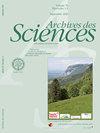The Relationship Between a Green, Low-carbon and Recycling Economy, Economic Policy and Industrial Structure Development
Q3 Multidisciplinary
引用次数: 0
Abstract
This article critically examines Charles Bonnet’s seminal contributions to experimental science, particularly through his influential work, ‘Research on the Use of Leaves.’ The primary objective is to delineate the functions and forms of natural experimentation as they were understood and practiced in the mid-18th century. During this period, scientists esteemed experimentation as the zenith of scientific proof, acutely cognizant of its multifaceted functional and typological aspects. Their methodology was characterized by a detailed narration of research methodologies, fostering a ‘rhetoric of transparency’ in scientific discourse. Nevertheless, the advent of new norms in scientific discourse during the 19th century, coupled with a paradigmatic philosophical shift in the 20th century, resulted in the marginalization of empirical practices of the Enlightenment era. Contemporary historians are now endeavoring to reconcile significant terminological discrepancies and to recontextualize the divergent methodologies among natural historians of that epoch. This involves a critical distinction between exploratory and demonstrative (or discriminant) forms of experimentation. Bonnet’s systematic preference for discriminant experimentation serves as a quintessential example of the logical approach in natural history. However, this perspective does not wholly represent the 18th-century ‘art of observation,’ which embraced a plethora of methodologies including taxonomy, anatomical dissection, chemical analysis, and physical measurements.绿色、低碳和循环经济与经济政策和产业结构发展的关系
这篇文章批判性地研究了查尔斯-波奈对实验科学的开创性贡献,尤其是通过他极具影响力的著作《叶的使用研究》。文章的主要目的是描述 18 世纪中叶人们所理解和实践的自然实验的功能和形式。在这一时期,科学家们将实验视为科学证明的顶峰,敏锐地认识到其多方面的功能和类型。他们的方法论的特点是详细叙述研究方法,在科学话语中形成了 "透明修辞"。然而,19 世纪科学话语中新规范的出现,加上 20 世纪哲学范式的转变,导致启蒙时代的实证实践被边缘化。当代历史学家现在正努力调和术语上的重大差异,并将那个时代自然历史学家之间不同的方法论重新语境化。这涉及到对探索性实验和演示性(或辨别性)实验形式的重要区分。波奈系统性地偏好判别实验,是自然史逻辑方法的典型范例。然而,这种观点并不能完全代表 18 世纪的 "观察艺术",它包含了分类学、解剖学、化学分析和物理测量等多种方法。
本文章由计算机程序翻译,如有差异,请以英文原文为准。
求助全文
约1分钟内获得全文
求助全文
来源期刊

Archives Des Sciences
综合性期刊-综合性期刊
CiteScore
1.10
自引率
0.00%
发文量
0
审稿时长
1 months
期刊介绍:
Archives des Sciences est un journal scientifique multidisciplinaire et international. Les articles sont soumis à un comité
de lecture.
 求助内容:
求助内容: 应助结果提醒方式:
应助结果提醒方式:


